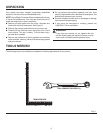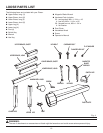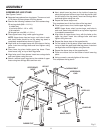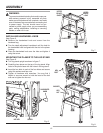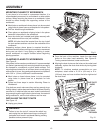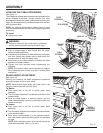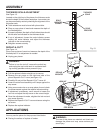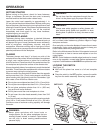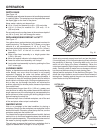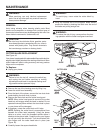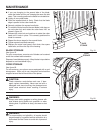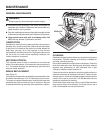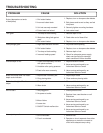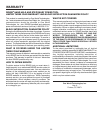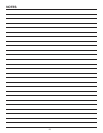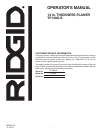
MAINTENANCE
GENERAL MAINTENANCE
WARNING:
Always begin by disconnecting the power supply.
Periodically check all clamps, nuts, bolts, and screws for
tightness and condition. Make sure the throat plate is in
good condition and in position.
Stop the machine and recheck the cutter head gib screws
and blades for tightness after about 50 hours of operation.
Clean plastic parts only with a soft damp cloth. DO
NOT use any aerosol or petroleum solvents.
LUBRICATION
Periodically, check all moving parts (spindle, roller surfaces,
handles, etc.) to ensure they are clean and well lubricated.
A light film of oil wiped on the face of the cutter blades will
keep them rust-free. All of the bearings in this tool are
lubricated with a sufficient amount of high grade lubricant for
the life of the unit under normal operating conditions. No
further lubrication is required.
MOTOR/ELECTRICAL
The universal motor is easy to maintain but must be kept
clean. Do not allow water, oil or sawdust to accumulate on or
in it. The sealed bearings are permanently lubricated and
need no further attention.
BRUSH REPLACEMENT
See Figure 21.
Your planer has externally accessible brush assemblies that
should be checked every 10 to 15 operating hours for wear.
To inspect or replace these brushes, unscrew the brush cap
located at the right front and left rear of the planer. Be sure
to replace the brush cap securely after inspection or repairs.
3
1/8
3/32
1/16
1/32
0
2.5
2
1.5
1
.5
0
Ind
I
Cut
1
Repeat
Cut
A
-
-
1
1
1
1
1
3
3
2
2
"
"
4
4
4
4
8
1
1
1
6
5
4
2
1
0
0
1
2
3
4
5
6
7
8
9
10
11
12
13
14
15
3
Fig. 21
BRUSH CAP
BRUSH
20
CLEANING
Sawdust buildup and other debris can cause the tool to plane
inaccurately. Periodic cleaning and waxing is needed for
accurate, precision planing.
Do not allow sawdust to accumulate on the planer. Clean the
dust chute after each use. Moving parts should be cleaned
regularly with penetrating oil and lubricated with a light
coating of medium-weight machine oil.
Paste wax should be applied to the planing table surface to
ease the movement of workpieces across it. Paste wax can
also be used on infeed and outfeed support surfaces but be
careful not to use so much that it will be absorbed into the
wood and interfere with staining.
Check feed rollers after each use for resin buildup because
they must be clean to be effective. If buildup occurs, use a
mild, nonflammable tar and pitch remover.



